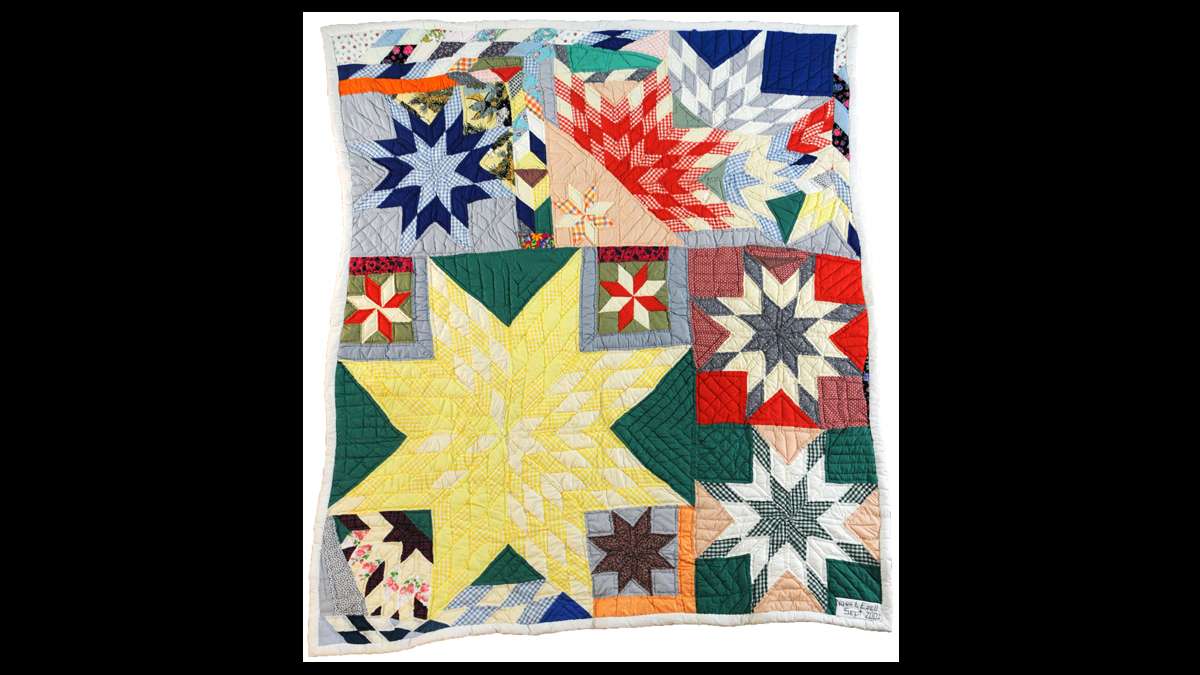New Jersey exhibit of African-American quilts coincides with 50th anniversary of the Civil Rights Act
During the short dark days, many fight the urge to hide under the covers. An exhibition of quilts, timed to coincide with the 50th anniversary of the Civil Rights Act, could provide needed comfort. The Montclair Art Museum is exhibiting From Heart to Hand: African-American Quilts through January 4, 2015.
There are star quilts and log cabin designs, geometric patterns that look like Modern art, and even quilts depicting baseball diamonds and the story of Noah’s Ark. Quilts are a quintessential American art form, and African-American women have been among the least represented art groups in the institutional art world.
“These quilts have an amazing graphic power and offer an important visual narrative reflecting African-American social history,” said Montclair Art Museum Director Lora Urbanelli.
Part of the permanent collection of the Montgomery Museum of Fine Arts inMontgomery, Ala., most of the quilts were made between the mid-1950s and the end of the 20th century, and represent themes in traditional quiltmaking with roots in African textiles. The exhibition includes examples of pieced quilts and appliqué, as well as the improvisational techniques and use of unconventional materials that are common practice for contemporary quiltmakers.
“The creators of these quilts… are among the most respected artisans of this medium, both within the region and nationally,” said Gail Stavitsky, MAM’s chief curator. “Quiltmaking is often a community-based art form, in that older relatives or neighbors instruct younger quilters in the skills and aesthetics that the family uses to design, assemble, and stitch.”
Each quiltmaker brings her own personal vision to the process. Though their origins and materials may be humble, quilts have become regular features in art museums over the past several decades. There has been a rising interest in quilts made by African-American women, many of whom hail from isolated rural areas. Several communities in Alabama, including Gee’s Bend and Eutaw, have received a new appreciation for their aesthetic appeal.
When 60 quilts from Gees Bend were exhibited at the Whitney Museum of American Art in 2002, New York Times art critic Michael Kimmelman referred to them as not just “eye-poppingly gorgeous” but “some of the most miraculous works of modern art America has produced.”
The abstract geometric patterns were stitched out of old denim jeans, cornmeal sacks, Sears corduroy swatches and hand-me-down leisure suits — whatever materials were on hand.
When traditional quilts, made for warmth, were draped over beds, patterns such as Lone Star and log cabin became a source of pride and added vibrancy to a room. Of all the geometric patterns found in quilting, the star is probably the most common. The Lone Star pattern is considered the most difficult — one mistake in the early stages of construction can cause the star to pucker. Traditionally, these patterns have been respected as one of the real challenges of quilt making and out of reach of the average quilter.
A “talking quilt” is one that conveys Bible verse. People from the Gee’s Bend area use the term Housetop for a quilt design dominated by concentric squares. Other quilters call the same design Pig Pen, particularly when the center block is of four or six patches. There’s even an “Everybody Quilt,” a sampler of different patterns and leftover blocks from other quilts. The term “Everybody Quilt” usually means that a group of quilters contributed, but in this case it was completed by one artist.
As artists, these quiltmakers were compelled to do something more innovative, to express their own feelings using symbols of their lives. It is interesting to see how these elements take shape in the work of contemporary quiltmaker Yvonne Wells. Beginning in 1979, Wells began creating practical quilts for her own use. These were pieced and hand-sewn according to traditional methods.
Around 1983, the quilts created by the retired educator began to assume a narrative approach, and she adopted the technique of appliqué. She takes inspiration from the holy Bible, the Civil Rights Movement, and popular culture. Featured here are quilts of Elvis, Jackie Robinson, Rosa Parks and Helen Keller. Wells may do up to 20 quilts in a month, staying up all night because she finds the work so satisfying.
Many of Wells’ works deal with abstract themes of emotion and human relationships, and Wells’ techniques have been compared to those of painters. Her compositions may exist in her head until all basic elements are cut out and laid on top of the fabric square that is destined to become the quilt top. From there, she adds fabric accents, found objects, beads and other bric-a-brac. All of Wells’ quilts are completely handmade, without a sewing machine.
The Montclair Art Museum presents From Heart to Hand: African-American Quilts from the Montgomery Museum of Fine Arts through January 4, 2015. 3 South Mountain Avenue, Montclair; www.montclairartmuseum.org
_____________________________________________
The Artful Blogger is written by Ilene Dube and offers a look inside the art world of the greater Princeton area. Ilene Dube is an award-winning arts writer and editor, as well as an artist, curator and activist for the arts.
WHYY is your source for fact-based, in-depth journalism and information. As a nonprofit organization, we rely on financial support from readers like you. Please give today.














